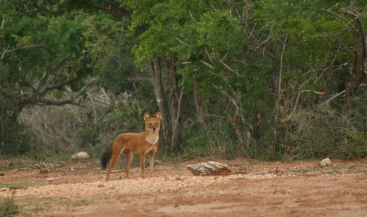The Canine Rulers of Sigur Plateau (2017)
- sherjinjoel
- Jun 9
- 3 min read
Updated: Sep 21
Nestled within the Nilgiri Biosphere Reserve, the Sigur Plateau stands as one of the most ecologically critical corridors in Southern India. Spanning scrub jungles and deciduous forests, this rugged landscape plays a vital role in linking the Western and Eastern Ghats—serving as a natural bridge that sustains both genetic flow and predator-prey dynamics across ecosystems.
But what sets Sigur apart isn’t just its role in connectivity. It is one of the very few places in India where blackbuck and tiger share the same terrain. In most parts of the country, blackbuck have long vanished from tiger habitats. But here, they remain—graceful antelopes grazing cautiously in the presence of the apex predator, evoking a scene from a wilder, older India.
Yet, even in this land of big cats, it is not the tiger alone that rules.

Meet the Dholes, the Wild Dogs
Roaming the thickets of Sigur are the dholes—the lesser-known but no less formidable Asiatic wild dogs (Cuon alpinus). Locally referred to as red dogs, these canids are distinguished by their rusty coats, bushy tails, and intense social cohesion. Despite being spread across the Indian subcontinent—from the tropical rainforests of Kalakkad-Mundanthurai in Tamil Nadu to the Himalayan foothills—their populations are dangerously low, estimated at fewer than 2,500 individuals. Today, they are classified as Endangered by the International Union for Conservation of Nature (IUCN).
In many ways, dholes resemble a fusion of wolf and feral dog, albeit more compact. But what they may lack in size, they more than make up for in strategy and endurance. Dholes hunt in packs, employing a collective tactic of chasing prey to exhaustion before launching a coordinated attack—typically from the rear, where the prey is most vulnerable.
What’s particularly fascinating—and often overlooked—is that dholes are known to challenge, and occasionally bring down, leopards and even tigers. While such encounters are rare and perilous, they have been well-documented in historical accounts.
Documented Accounts from the Wild
In the 1850s, naturalist R.A. Sterndale recorded an instance of dholes bringing down a tiger in what is now Satpura Tiger Reserve.
Early 20th-century hunter-writer Col. Faunthorpe echoed similar stories.
Perhaps most vividly, Kenneth Anderson in Tiger Roams recounted an incident where multiple dhole clans joined forces to outmaneuver and kill a tiger, describing their coordination and social intelligence in remarkable detail.
Such attacks are not motivated by hunger, but by eliminating competition—a calculated move in ecosystems where prey is limited and every advantage counts.
An Intricate Social Structure - the secret of Dholes' habitat domination
The social life of the dhole is just as compelling as its hunting behavior. Unlike wolves, there’s no overt dominance hierarchy within a pack. Pups and nursing females often get priority at a kill. Some clans dwell in multi-chambered underground dens, passed down across generations—echoes of ancestral memory etched into the land.
Dholes are also inherently social—they engage in play, greeting rituals, and even friendly sparring sessions with neighboring packs. These interactions not only strengthen group bonds but also serve as informal diplomacy between territories.
My first Sighting of Dhole pack in Masinagudi
On a recent visit to Masinagudi (year 2017), located at the edge of the Sigur Plateau, I had the rare privilege of observing a pack of dholes at a distance—alert, precise, and quietly dominant. It was a fleeting glimpse, yet one that spoke volumes about their presence.
My sincere thanks to Jungle Hut, and to naturalists Surya Ramachandran and Ahmed for making this moment possible, in a setting that offered both ecological richness and warm hospitality.

In a landscape shaped by time, survival, and instinct, the dholes of Sigur Plateau embody the raw pulse of the wild. Often overshadowed by the tiger, they are, in truth, equally deserving of admiration. Their presence speaks to a wilderness still intact, still brimming with complex interactions and untold stories.
As habitat loss and prey decline threaten their future, it becomes all the more essential to recognize their role—not just as hunters, but as indicators of a thriving ecosystem.
Because where the dhole roams freely, the forest is still alive.
If you’ve made it this far, thank you for sticking with this story. If you have a moment, please scroll to the bottom of this page and share your thoughts. I’d be deeply grateful.















So interesting!